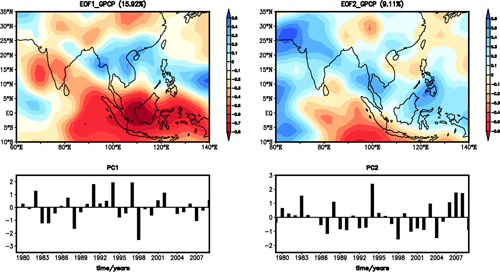During the prevailing period of the Asian summer monsoon, the maximum rainfall centers are located over the Indo-China Peninsula, Bay of Bengal, northeastern Indian Ocean, and southeastern Maritime Continent. The sub-monsoon systems over the Asian-Pacific region have close linkages, involving the ocean-atmospheric interaction, water vapor channels, etc. Thus, it is necessary to study the monsoon on the greater scale and better understand the variability of Asian-Pacific monsoon.
To address this question, Dr. GAO Ya, Prof. WANG Huijun and their colleagues from the Nansen-Zhu International Center of Institute of Atmospheric Physics proposed a new concept—the Pan-Asian monsoon region, which consists of the South Asian monsoon, East Asian monsoon, Western North Pacific monsoon and Southeast Asian monsoon. They analyzed the interannual variability of the summer precipitation dominant modes in Pan-Asian monsoon region and its impact factors using the reanalysed data. Based on the observation results, they use CMIP3 and CMIP5 models to evaluate the model reproducibility and the ENSEMBLES models to investigate the model predictability.
The results shows that the first EOF mode of the summer precipitation has close relationship with the simultaneous ENSO, the preceding spring and simultaneous summer Antarctic Oscillation in Pacific Ocean and Pacific-South American patterns. The first EOF mode is therefore named as the Pacific mode. The second precipitation mode is associated with the atmospheric convection and the Antarctic Oscillation in the Indian Ocean, and it is then named as the Indian Ocean mode.

Figure 1: The climatology of summer precipitation (May to September) during 1979–2013 (Figure plotted by GAO Ya)
"We also found the selected CMIP5 models and MME are more skillful in simulating the dominant mode of the summer precipitation in Pan-Asian monsoon region, compared with the CMIP3 models’ results.” Says Dr. GAO, “We think it is due to the improved ENSO pattern and the air-sea interaction of the Southern Hemisphere.” The evaluation of the ENSEMBLES models shows that these models have good capabilities in reproducing the summer precipitation principle modes, due to the well captured associated ocean and atmospheric circulation indicators.

Figure 2: The first two leading EOF modes of the Pan-Asian Monsoon summer precipitation and their corresponding principal component over the period of 1979–2009. The first mode explained 15.92% of total variance; the second mode explained 9.11% of total variance (Gao and Wang, 2015)
References:
1) Gao Y, and Wang H J. 2012. Pan-Asian Monsoon and its definition, principal modes of precipitation, and variability features. Science China Earth Sciences, 55: 1–9.
2) Gao Y, Wang H J, Jiang D B. 2015. An intercomparison of CMIP5 and CMIP3 models for interannual variability of summer precipitation in Pan-Asian monsoon region. International Journal of Climatology, doi:10.1002/joc.4245.
3) Gao Y, Wang H J, Chen D. 2015. The capability of ENSEMBLES models in predicting the principal modes of Pan-Asian monsoon precipitation. Journal of Climate, 28: 8486–8510, doi: http://dx.doi.org/10.1175/JCLI-D-15-0010.1.
Contact:
Dr. GAO Ya, rainbow_colour@163.com







